Us semi-pro eBay reel collectors are occasional victims of unchecked avarice – greed mostly. The pictures omit the missing screw, the bent rim, and the seller that’s hoping you won’t notice an unsightly wobble or loose spool.
That’s because we’ve got visions of Sugarplums dancing – the missing 3 1/4″ Hardy Princess Multiplier that we’ve lusted after for a decade has finally shown itself, and the “Buy it Now” button looms large and vibrant.
We open the box later to find a hint of malice – then gash ourselves for trusting anyone from Connecticut, especially with a seller ID like “Pwned.”
Fixing these aging warriors is a labor of love for me, akin to tying flies – with each scratch and wobble telling of great deeds and greater pratfalls, all in the name of fishing.
The spool latch mechanism is one of the few moving parts on a fly reel that is prone to eventual failure, yet so simplistic that it requires little more than a staple or hairpin to give a reel another hundred years of life.
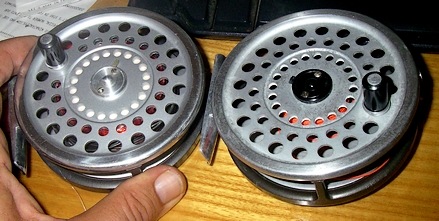
Above are the two styles of System reels made by Hardy for Scientific Anglers. The black plastic center cap is the older series and had a poorly designed latch mechanism made from plastic – which failed early and often.
The second series replaced the plastic latch with the traditional aluminum cover and latch assembly common to all other Hardy models – a time tested design offering a greater lifespan.
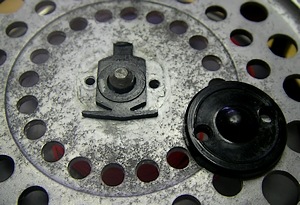
Failure of the plastic assembly means the “feet” have weakened and need to be returned to their original shape.
Remove the cap to expose the plastic latch underneath. The two feet at the base of the plastic latch press against the cover to give the “spring” effect. Once the feet weaken and achieve a shape matching the interior of the cover – they’ll allow the spool to slide right off the center spindle. To repair the issue, merely pull the two feet back into a straight line as shown above, that’ll return it to a “spring” (as it’s pressed against the interior of the cap cover) and allow the spool to be mounted or dismounted while retaining latch integrity.
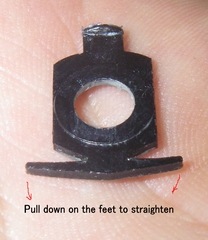 It’s a bad design, plastic just doesn’t have the longevity, and fatigues much quicker than the surrounding metal.
It’s a bad design, plastic just doesn’t have the longevity, and fatigues much quicker than the surrounding metal.
It appears wrapping some fly tying thread at the neck would also offer additional resistance to the feet being deformed – and for the terminal case, perhaps a replacement could be crafted from the stiff plastic of a pill bottle top.
The metal capped Hardy latches are a much sturdier design, but even metal springs weaken over time and have to be replaced.
The latch itself is a bar of aluminum or steel that’s been riveted to the spool. A small “V” of spring steel lies adjacent the bar and its contact with the interior of the cap provides the spring holding the latch tight against the center spindle.
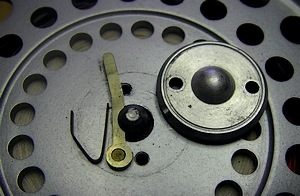
If the spring breaks it can be replaced with a similar “V” made from a hairpin or a spring steel staple from a heavy cardboard box.
Depending on the width of the flat replacement wire – you may have to grind it down a bit to fit under the aluminum cap.
Most of the time you can simply spread the existing spring outward, giving yourself another couple of decades before you’ll have to repeat the process.
Despite all the advances in reel design and materials, the latch mechanism is still quite simplistic – and over time the spring material will lose its vigor and need some coaxing. Contemporary large arbor reels are no different – and cracking open one of these engineering marvels can reveal equally simplistic mechanisms that’ll be prone to the same longevity issues.
The old Hardy’s use brass screws to hold the cap assembly in place, and these deform really easily. Make sure your screwdriver is sized to get complete purchase on the slot, if it’s too big it’ll shred the screw instantly leaving a ridge of razor sharp metal to greet them fingers.

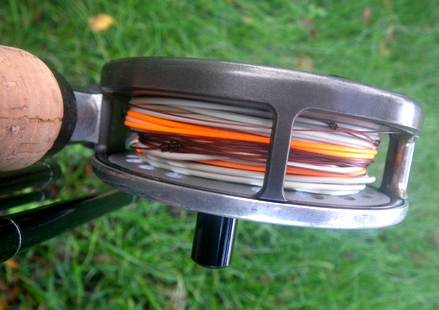
They say that eventually, dog owners end up looking like their dogs, so I’ve gotta wonder what happens to a fly fisherman after decades of fishing beat-up, dented, kinda loud & ugly reels.
Just wondering – and all purely in the interest of furthering scientific knowledge.
They’re much quieter when rigged for “cast right, reel right” – like God intended..
It was a courtesy of the Hardy reel works that ‘reeling left’ was announced loudly – equivalent to “swinging both ways.”